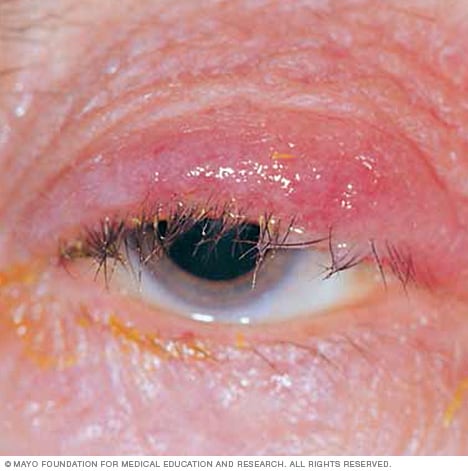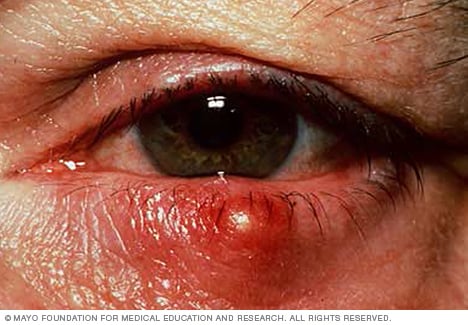Blepharitis
![]() August, 10th, 2023
August, 10th, 2023
Benefit Summary
This often chronic eyelid condition can be difficult to treat. It might be uncomfortable, but it doesn’t usually damage eyesight and isn’t contagious.
Overview
, Overview, ,
Blepharitis (blef-uh-RYE-tis) is inflammation of the eyelids. Blepharitis usually affects both eyes along the edges of the eyelids.
Blepharitis commonly occurs when tiny oil glands near the base of the eyelashes become clogged, causing irritation and redness. Several diseases and conditions can cause blepharitis.
Blepharitis is often a chronic condition that’s difficult to treat. Blepharitis can be uncomfortable and unsightly. But it usually doesn’t cause permanent damage to your eyesight, and it’s not contagious.

Blepharitis signs and symptoms are typically worse in the morning. They include:
- Watery eyes
- Red eyes
- A gritty, burning or stinging sensation in the eyes
- Eyelids that appear greasy
- Itchy eyelids
- Red, swollen eyelids
- Flaking of the skin around the eyes
- Crusted eyelashes
- Eyelid sticking
- More frequent blinking
- Sensitivity to light
- Blurred vision that usually improves with blinking
When to see a doctor
If you have blepharitis signs and symptoms that don’t seem to improve despite good hygiene — regular cleaning and care of the affected area — make an appointment with your doctor.
Causes
The exact cause of blepharitis isn’t clear. It might be associated with one or more of the following:
- Seborrheic dermatitis — dandruff of the scalp and eyebrows
- Infection
- Clogged or malfunctioning oil glands in your eyelids
- Rosacea — a skin condition characterized by facial redness
- Allergies, including allergic reactions to eye medications, contact lens solutions or eye makeup
- Eyelash mites or lice
- Dry eyes
Complications
If you have blepharitis, you might also have:
- Eyelash problems. Blepharitis can cause your eyelashes to fall out, grow abnormally (misdirected eyelashes) or lose color.
- Eyelid skin problems. Scarring can develop on your eyelids from long-term blepharitis. Or the eyelid edges might turn inward or outward.
-
Excess tearing or dry eyes. Abnormal oily secretions and other debris shed from the eyelids, such as flaking associated with dandruff, can build up in your tear film — the water, oil and mucus solution that forms tears.
Abnormal tear film interferes with keeping your eyelids moist. This can irritate your eyes and cause symptoms of dry eyes or excess tearing.
- Stye. A stye is an infection that develops near the base of the eyelashes. The result is a painful lump on the edge of your eyelid. A stye is usually most visible on the surface of the eyelid.
- Chalazion. A chalazion occurs when there’s a blockage in one of the small oil glands at the margin of the eyelid, just behind the eyelashes. This blockage causes inflammation of the gland, which makes the eyelid swell and redden. This can clear up or turn into a hard, nontender bump.
- Chronic pink eye. Blepharitis can lead to recurrent bouts of pink eye (conjunctivitis).
- Injury to the cornea. Constant irritation from inflamed eyelids or misdirected eyelashes can cause a sore to develop on your cornea. Not having enough tears could increase your risk of a corneal infection.

Tests and procedures used to diagnose blepharitis include:
- Examining your eyes. Your doctor might use a special magnifying instrument to examine your eyelids and your eyes.
- Swabbing skin for testing. In certain cases, your doctor might use a swab to collect a sample of the oil or crust that forms on your eyelid. This sample can be analyzed for bacteria, fungi or evidence of an allergy.
Treatment
Self-care measures, such as washing your eyes and using warm compresses, might be all that’s needed for most cases of blepharitis. If self-care measures aren’t enough, your doctor might suggest prescription treatments, including:
-
Medications that fight infection. Antibiotics applied to the eyelid have been shown to provide relief of symptoms and resolve bacterial infection of the eyelids. These are available in several forms, including eyedrops, creams and ointments.
If you don’t respond to topical antibiotics, your doctor might suggest an oral antibiotic.
- Medications to control inflammation. Steroid eyedrops or ointments are used for this, generally only for people who don’t respond to other therapies. Your doctor might prescribe both antibiotic and anti-inflammatory drugs.
- Medications that affect the immune system. Topical cyclosporine (Restasis) has been shown to offer relief of some signs and symptoms of blepharitis.
- Treatments for underlying conditions. Blepharitis caused by seborrheic dermatitis, rosacea or other diseases might be controlled by treating the underlying disease.
Other treatment options, such as using intense pulsed light might unclog the glands. More study is needed.
Blepharitis rarely disappears completely. Even with successful treatment, the condition frequently is chronic and requires daily attention with eyelid scrubs. If you don’t respond to treatment, or if you’ve also lost eyelashes or only one eye is affected, the condition could be caused by a localized eyelid cancer.
Self care
Self-care measures might be the only treatment needed for most cases of blepharitis.
Clean your eyes daily
If you have blepharitis, follow this self-care remedy two to four times a day during flare-ups and once or twice a day after the condition is under control:
- Apply a warm compress over your closed eye for a few minutes to loosen the crusty deposits on your eyelids.
- Firmly but gently massage the eyelids, using a clean washcloth or a clean finger.
- Immediately use a clean washcloth or cotton-tipped applicator moistened with warm water and a few drops of diluted baby shampoo or an over-the-counter eyelid cleanser to wash away oily debris or scales at the base of your eyelashes. Use a different clean cloth for each eye.
-
In some cases, you might need to be more deliberate about cleaning the edge of your eyelids at your eyelashes. To do this, gently pull your eyelid away from your eye and use the washcloth to gently rub the base of the lashes. This helps avoid damaging your cornea with the washcloth.
Ask your doctor whether you should use a topical antibiotic ointment after cleaning your eyelids in this way.
- Rinse your eyelids with warm water and gently pat them dry with a clean, dry towel.
It might help to stop using eye makeup when your eyelids are inflamed. Makeup can make it harder to keep your eyelids clean and free of debris. Also, it’s possible that makeup could reintroduce bacteria to the area or cause an allergic reaction.
Lubricate your eyes
Try over-the-counter artificial tears. These eyedrops can help relieve dry eyes.
Control dandruff and mites
If you have dandruff that’s contributing to your blepharitis, ask your doctor to recommend a dandruff shampoo. Using a dandruff shampoo might relieve your blepharitis signs and symptoms.
Using tea tree oil shampoo on your eyelids daily might help deal with mites. Or try gently scrubbing your lids once a week with 50% tea tree oil, which is available over-the-counter. Contact your doctor if you don’t see improvement in six weeks. And stop using tea tree oil if it irritates your skin or eyes.
Alternative medicine
No alternative medicine treatments have been proved to ease the symptoms of blepharitis. However, a diet rich in omega-3 fatty acids or supplements containing omega-3 fatty acids might help blepharitis associated with rosacea. Omega-3 fatty acids are found in foods such as salmon, tuna, trout, flaxseed and walnuts. More study is needed.
Preparing for your appointment
You’re likely to start by seeing your family doctor. If your doctor suspects you may have an eyelid problem, such as blepharitis, you might be referred to an eye specialist (optometrist or ophthalmologist).
Here’s some information to help you get ready for your appointment.
What you can do
Make a list of the following:
- Your symptoms, including any that may seem unrelated to blepharitis, and when they began
- All medications, vitamins or other supplements you take, including doses
- Questions to ask your doctor
For blepharitis, questions to ask your doctor include:
- What is likely causing my symptoms?
- What are other possible causes for these symptoms?
- What medical conditions can cause this problem?
- What tests will I need?
- Should I see a specialist?
- Are there brochures or other printed material I can have? What websites do you recommend?
- Can I continue to wear contact lenses?
- Do I need to take special care cleaning my contact lenses and my carrying case?
- Can I continue to wear eye makeup?
- Will I need a follow-up visit? If so, when?
Don’t hesitate to ask other questions.
What to expect from your doctor
Your doctor is likely to ask you questions, such as:
- Do your symptoms come and go, or do you always have them?
- Are your symptoms worse in the morning or later in the day?
- Have you been wearing contact lenses?
- Have you changed cosmetic brands recently?
- Have you changed soap or shampoo brands recently?
- Does anything seem to improve your symptoms?
- What, if anything, appears to worsen your symptoms?
- Has anyone close to you had a recent eye infection?
- Have you ever had any eye diseases, eye surgeries or eye injuries?
- Do you have other diseases or conditions?
What you can do in the meantime
While waiting for your appointment, you might find relief from eye irritation by gently washing your eyelids a few times each day. To wash your eyelids:
- Apply a warm washcloth to your closed eyelids for up to five minutes.
- Gently rub your closed eyelids with a diluted solution of baby shampoo. Use a clean washcloth or clean fingers. You might need to hold the lid away from your eye to rub along the lash margin. Removing the scales might require several minutes of gentle rubbing.
- Rinse your eyes thoroughly with warm water.
Avoid anything that irritates your eyes, such as eye makeup and contact lenses.
© 1998-2025 Mayo Foundation for Medical Education and Research (MFMER). All rights reserved. Terms of Use



